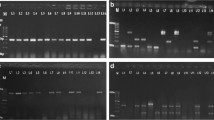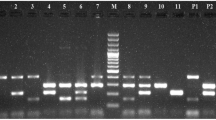Abstract
This study aimed to detect virulence factors, pathovars, and phylogenetic groups of Escherichia coli strains obtained from feces of calves with and without diarrhea up to 70 days old and to determine the association between occurrence of diarrhea, phylogenetic groups, and pathovars. Phylo-typing analysis of the 336 E. coli strains isolated from calves with Clermont method showed that 21 (6.25 %) belong to phylogroup A, 228 (67.85 %) to phylogroup B1, 2 (0.6 %) to phylogroup B2, 5 (1.49 %) to phylogroup C, 57 (16.96 %) to phylogroup E, and 3 (0.9 %) to phylogroup F. Phylogroup D was not identified and 20 strains (5.95 %) were assigned as “unknown.” The distribution of phylogenetic groups among pathovars showed that NTEC belong to phylogroups B1 (17) and C (4); EPEC to phylogroups B1 (6) and E (8); STEC to phylogroups A (5), B1 (56), B2 (2), C (1), and E (15); EHEC to phylogroups B1 (95) and E (5); and ETEC to phylogroups A (3), B1 (7), and E (10). The EAST-1 strains were phylogroups A (13), B1 (47), E (19), and F (3); E. coli strains of “unknown” phylogroups belonged to pathovars EPEC (1), EHEC (2), STEC (7), and EAST-1 strains (6). ETEC was associated with diarrhea (P = 0.002). Our study did not find association between the phylogenetic background and occurrence of diarrhea (P = 0.164) but did find some relationship in phylogenetic group and pathovar. The study showed that EHEC and STEC are classified as phylogroup B1, EAST-1 phylogroup A, ETEC, and EPEC phylogroup E.

Similar content being viewed by others
References
Aidar-Ugrinovich L, Blanco J, Blanco M et al (2007) Serotypes, virulence genes, and intimin types of Shiga toxin-producing Escherichia coli (STEC) and enteropathogenic E. coli (EPEC) isolated from calves in São Paulo, Brazil. Int J Food Microbiol 115:297–306. doi:10.1016/j.ijfoodmicro.2006.10.046
Andrade GI, Coura FM, Santos ELS et al (2012) Identification of virulence factors by multiplex PCR in Escherichia coli isolated from calves in Minas Gerais, Brazil. Trop Anim Health Prod 44:1783–1790. doi:10.1007/s11250-012-0139-8
Badouei MA, Salehi TZ, Khorasgani MR et al (2010) Virulence gene profiles and intimin subtypes of Shiga toxin-producing Escherichia coli isolated from healthy and diarrhoeic calves. Vet Rec 167:858–861. doi:10.1136/vr.c4009
Baldy-Chudzik K, Mackiewicz P, Stosik M (2008) Phylogenetic background, virulence gene profiles, and genomic diversity in commensal Escherichia coli isolated from ten mammal species living in one zoo. Vet Microbiol 131:173–184. doi:10.1016/j.vetmic.2008.02.019
Bardiau M, Szalo M, Mainil JG (2010) Initial adherence of EPEC, EHEC and VTEC to host cells. Vet Res 41:57. doi:10.1051/vetres/2010029
Bartels CJM, Holzhauer M, Jorritsma R et al (2010) Prevalence, prediction and risk factors of enteropathogens in normal and non-normal faeces of young Dutch dairy calves. Prev Vet Med 93:162–169. doi:10.1016/j.prevetmed.2009.09.020
Bertin Y, Martin C, Oswald E, Girardeau JP (1996) Rapid and specific detection of F17-related pilin and adhesin genes in diarrheic and septicemic Escherichia coli strains by multiplex PCR. J Clin Microbiol 34:2921–2928
Blanco M, Blanco IE, Blanco J et al (1996) Polymerase chain reaction for detection Escherichia coli strains producing cytotoxic necrotizing factor type 1 and type 2 ( CNFl and CNF2). J Microbiol Methods 26:95–101
Clermont O, Olier M, Hoede C et al (2011) Animal and human pathogenic Escherichia coli strains share common genetic backgrounds. Infect Genet Evol 11:654–662. doi:10.1016/j.meegid.2011.02.005
Clermont O, Christenson JK, Denamur E, Gordon DM (2013) The Clermont Escherichia coli phylo-typing method revisited: improvement of specificity and detection of new phylo-groups. Environ Microbiol Rep 5:58–65. doi:10.1111/1758-2229.12019
Coura FM, Lage AP, Heinemann MB (2014) Patotipos de Escherichia coli causadores de diarreia em bezerros: uma atualização. Pesqui Vet Bras 34:811–818
Coura FM, Freitas MD, Ribeiro J et al (2015a) Longitudinal study of Salmonella spp., diarrheagenic Escherichia coli, Rotavirus, and Coronavirus isolated from healthy and diarrheic calves in a Brazilian dairy herd. Trop Anim Health Prod 47:3–11. doi:10.1007/s11250-014-0675-5
Coura FM, Diniz SDA, Silva MX et al (2015b) Phylogenetic group determination of Escherichia coli isolated from animals samples. Sci world 2015:1–4
Croxen MA, Law RJ, Scholz R et al (2013) Recent advances in understanding enteric pathogenic Escherichia coli. Clin Microbiol Rev 26:822–880. doi:10.1128/CMR.00022-13
Escobar-Páramo P, Clermont O, Blanc-Potard AB et al (2004) A specific genetic background is required for acquisition and expression of virulence factors in Escherichia coli. Mol Biol Evol 21:1085–1094. doi:10.1093/molbev/msh118
Etcheverría AI, Padola NL (2013) Shiga toxin-producing Escherichia coli: factors involved in virulence and cattle colonization. Virulence 4:366–372. doi:10.4161/viru.24642
Galli L, Miliwebsky E, Irino K et al (2010) Virulence profile comparison between LEE-negative Shiga toxin-producing Escherichia coli (STEC) strains isolated from cattle and humans. Vet Microbiol 143:307–313. doi:10.1016/j.vetmic.2009.11.028
Greenacre M, Blasius J (2006) Multiple correspondence analysis and related methods. Chapman-Hall, Florida
Gunzburg ST, Tornieporth NG, Riley LW (1995) Identification of enteropathogenic Escherichia coli by PCR-based detection of the bundle-forming pilus gene. J Clin Microbiol 33:1375–1377
Iranpour D, Hassanpour M, Ansari H, et al (2015) Phylogenetic groups of Escherichia coli strains from patients with urinary tract infection in Iran based on the new clermont phylotyping method. 2015:5–12
Jenkins C, Perry NT, Cheasty T et al (2003) Distribution of the saa gene in strains of Shiga toxin-producing Escherichia coli of human and bovine origins. J Clin Microbiol 41:1775–1778. doi:10.1128/JCM.41.4.1775
Kolenda R, Burdukiewicz M, Schierack P (2015) A systematic review and meta-analysis of the epidemiology of pathogenic Escherichia coli of calves and the role of calves as reservoirs for human pathogenic E. coli. Front Cell Infect Microbiol. doi:10.3389/fcimb.2015.00023
Krause G, Zimmermann S, Beutin L (2005) Investigation of domestic animals and pets as a reservoir for intimin-(eae) gene positive Escherichia coli types. Vet Microbiol 106:87–95
Martin A, Beutin L (2011) Characteristics of Shiga toxin-producing Escherichia coli from meat and milk products of different origins and association with food producing animals as main contamination sources. Int J Food Microbiol 146:99–104. doi:10.1016/j.ijfoodmicro.2011.01.041
McDaniels AE, Rice EW, Reyes AL et al (1996) Confirmational identification of Escherichia coli, a comparison of genotypic and phenotypic assays for glutamate decarboxylase and B-D-glucuronidase. Appl Environ Microbiol 62:3350–3354
Mosquito S, Pons MJ, Riveros M, et al (2015) Diarrheagenic Escherichia coli phylogroups are associated with antibiotic resistance and duration of diarrheal episode. Sci World J 2015.
Moxley RA, Smith DR (2010) Attaching-effacing Escherichia coli infections in cattle. Vet Clin North Am Food Anim Pract 26:29–56 . doi:10.1016/j.cvfa.2009.10.011table of contents
Nguyen TD, Vo TT, Vu-Khac H (2011) Virulence factors in Escherichia coli isolated from calves with diarrhea in Vietnam. J Vet Sci 12:159. doi:10.4142/jvs.2011.12.2.159
Oliveira MG, Brito JRF, Gomes TAT et al (2008) Diversity of virulence profiles of Shiga toxin-producing Escherichia coli serotypes in food-producing animals in Brazil. Int J Food Microbiol 127:139–146. doi:10.1016/j.ijfoodmicro.2008.06.023
Paton AW, Srimanote P, Woodrow MC, Paton JC (2001) Characterization of Saa, a novel autoagglutinating adhesin produced by locus of enterocyte effacement-negative Shiga-toxigenic Escherichia coli strains that are virulent for humans. Infect Immun 69:6999–7009. doi:10.1128/IAI.69.11.6999-7009.2001
Pitcher D, Saunders NA, Owen RJ (1989) Rapid extraction of bacterial genomic DNA with guanidium thiocyanate. Lett Appl Microbiol 8:151–156
Salvarani S, Tramuta C, Nebbia P, Robino P (2012) Occurrence and functionality of cycle inhibiting factor, cytotoxic necrotising factors and cytolethal distending toxins in Escherichia coli isolated from calves and dogs in Italy. Res Vet Sci 92:372–377. doi:10.1016/j.rvsc.2011.04.019
Schmidt H, Beutin L, Karch H (1995) Molecular analysis of the plasmid-encoded hemolysin of Escherichia coli O157: H7 strain
StataCorp (2011) Stata statistical software: release 12. College Station, Texas
Tatarczak M, Wieczorek K, Possē B, Osek J (2005) Identification of putative adhesin genes in shigatoxigenic Escherichia coli isolated from different sources. Vet Microbiol 110:77–85. doi:10.1016/j.vetmic.2005.07.004
Tenaillon O, Skurnik D, Picard B, Denamur E (2010) The population genetics of commensal Escherichia coli. Nat Rev Microbiol 8:207–217. doi:10.1038/nrmicro2298
Tokuda K, Nishi J, Imuta N et al (2010) Characterization of typical and atypical enteroaggregative Escherichia coli in Kagoshima, Japan: biofilm formation and acid resistance. Microbiol Immunol 54:320–329. doi:10.1111/j.1348-0421.2010.00210.x
Toma C, Espinosa EM, Song T et al (2004) Distribution of putative adhesins in different seropathotypes of Shiga toxin-producing Escherichia coli. J Clin Microbiol 42:4937–4946. doi:10.1128/JCM.42.11.4937-4946.2004
Tramuta C, Robino P, Nebbia P (2008) Phylogenetic background of attaching and effacing Escherichia coli isolates from animals. Vet Res Commun 32:433–437. doi:10.1007/s11259-008-9042-1
Uber AP, Trabulsi LR, Irino K et al (2006) Enteroaggregative Escherichia coli from humans and animals differ in major phenotypical traits and virulence genes. FEMS Microbiol Lett 256:251–257. doi:10.1111/j.1574-6968.2006.00124.x
Um MM, Barraud O, Kérourédan M et al (2015) Comparison of the incidence of pathogenic and antibiotic-resistant Escherichia coli strains in adult cattle and veal calf slaughterhouse effluents highlighted different risks for public health. Water Res 88:30–38. doi:10.1016/j.watres.2015.09.029
Valat C, Forest K, Auvray F et al (2014) Assessment of adhesins as an indicator of pathovar-associated virulence factors in bovine Escherichia coli. Appl Environ Microbiol 80:7230–7234. doi:10.1128/AEM.02365-14
Van Bost S, Roels S, Mainil J (2001) Necrotoxigenic Escherichia coli type-2 invade and cause diarrhoea during experimental infection in colostrum-restricted newborn calves. Vet Microbiol 81:315–329. doi:10.1016/S0378-1135(01)00360-1
Veilleux S, Dubreuil JD (2006) Presence of Escherichia coli carrying the EAST1 toxin gene in farm animals. Vet Res 37:3–13
Yamamoto T, Nakazawa M (1997) Detection and sequences of the enteroaggregative Escherichia coli heat-stable enterotoxin 1 gene in enterotoxigenic E. coli strains isolated from piglets and calves with diarrhea. J Clin Microbiol 35:223–227
Acknowledgments
This work was supported by the Conselho Nacional de Desenvolvimento Técnico e Científico (CNPq 448357/2014-3) and Fundação de Amparo à Pesquisa do Estado de Minas Gerais (Fapemig). APL and MBH are indebted to CNPq for the fellowships received. FMC thanks CNPq and Capes (13827/13-8) for her fellowship.
Author information
Authors and Affiliations
Corresponding author
Ethics declarations
This study was conducted in agreement with the Ethical Principles in Animal Experimentation (CETEA/UFMG, protocol number 145/2006).
Conflict of interest
The authors declare that they have no conflict of interest.
Rights and permissions
About this article
Cite this article
Coura, F.M., de Araújo Diniz, S., Mussi, J.M.S. et al. Characterization of virulence factors and phylogenetic group determination of Escherichia coli isolated from diarrheic and non-diarrheic calves from Brazil. Folia Microbiol 62, 139–144 (2017). https://doi.org/10.1007/s12223-016-0480-9
Received:
Accepted:
Published:
Issue Date:
DOI: https://doi.org/10.1007/s12223-016-0480-9




